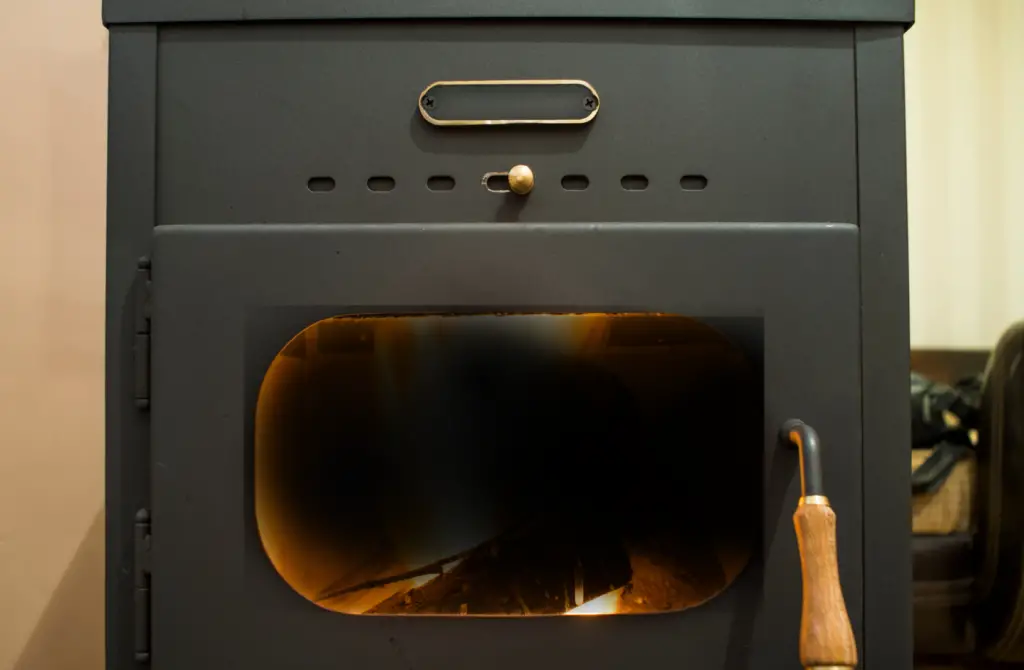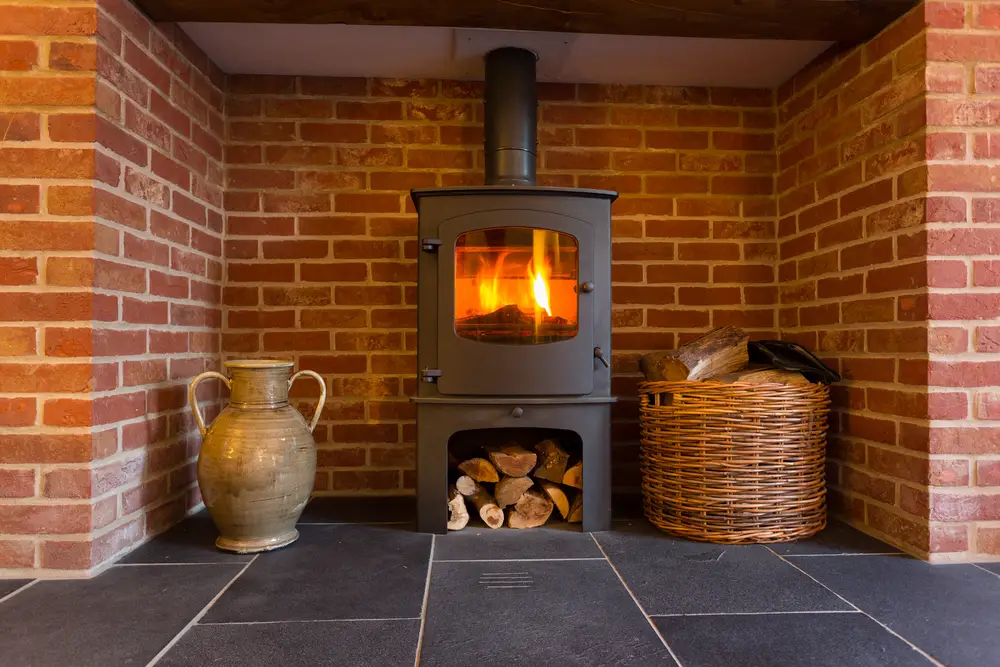You have just noticed that the glass on your wood-burning stove has turned black. It’s an eyesore, and you are wondering: why is my wood-burning stove glass black?
Your wood-burning stove glass can turn black due to excessive smoke from burning insufficiently seasoned wood. The glass will get black faster if the stove is too big for the space. An improper chimney or draught can also be responsible for the problem.
The good news is, there are easy ways to clean the glass and slow down blackening. I’m going to dive into the reasons behind this problem, and offer some solutions that you may find helpful.

Why is your log burner glass black?
Burning wet or insufficiently seasoned wood is the main reason for your wood stove glass to go black because incomplete combustion produces excessive smoke. Seasoned wood means wood with a moisture content below 20%. To achieve this, you have to cut and chop the wood and leave it for at least 6 months before you burn it.
A new model of wood-burning stove usually has an airwash system that prevents the buildup of soot on the glass. An incorrect use of this feature can also be responsible for a cloudy or black glass. When you are using the stove, do not completely close the airwash vent.
If the burning wood touches parts of the glass, those parts may turn black. Place the pieces of wood in a tight formation, 4-6 inches across. Then press the logs to the back of the firebox.
If you are burning household coal in your multi-fuel stove, the stove glass will turn black pretty quickly. When choosing an alternative to wood, choose a smokeless fuel such as anthracite, charcoal or coke.
Another possible reason is that your wood-burning stove is not probably burning hot enough—an issue that can also lead to condensation. Burning a small fire in a large stove will not produce optimal temperature, and therefore the airwash will not work correctly.
Last but not the least, smoke might linger in the firebox due to poor draught, causing the stove glass to turn black. Poor draught is characterized by a weak movement of smoke inside the chimney.

How to clean black glass on a log burner
To clean the glass on your wood-burning stove, you can use easily available things such as ashes, newspaper and vinegar. Here are some approaches that you might find convenient.
Use ashes and newspaper
The most tested way to get the job done is to use a little bit of wood ashes and some old newspaper. For this, you are also going to need a bowl of soapy water and a piece of cloth.
Dip a soft cloth into soapy water and then use the cloth to wipe the glass. If there is soot buildup, consider using elbow grease to cut through the soot.
Then use some scrunched up newspaper to scrub the glass. Take some ashes with the newspaper and scrub the glass in circular motions. At the end, use a piece of clean cloth to wipe away the residue.
Use vinegar
Another good approach is to use vinegar. In a spray bottle, mix vinegar with water (with a ratio of 1:3). Spray it over your stove glass and then use a clean towel to rub the glass. Repeat the process until you have removed the soot. Finally, wipe the glass with a clean paper towel.
Other methods
Apart from these two methods, there are some alternative ways to clean the glass. You can use household cleaning spray, degreaser or oven cleaner. However, before you use any chemical, read the instructions from the manufacturer and make sure the chemical is safe for glass.
You can mix some bicarbonate of soda with water and use the solvent as a cleaning agent. And if you are in a hurry, consider investing in a commercial stove glass cleaning spray. It will make the cleaning session quick and easy.

What not to do when cleaning your wood-burning stove
The process of cleaning your wood-burning stove glass does not have to be hard. Avoid making the following mistakes:
- Do not wait until the glass looks pitch-black. Clean it at regular intervals. The process is not easy when there are large amounts of soot on the glass.
- Do not clean the glass when it is too hot. Allow it to cool down before you touch it.
- Applying anything abrasive can scratch the glass. So, be careful when choosing a cleaner.
- If there are cracks in the glass, repair them before you use your wood-burning stove again.
- A dirty wood-burner glass indicates a dirty flu. To avoid dangerous chimney fires, get the flu swept regularly.
- Contact with anything sharp can scratch the glass. So, avoid using a still tool or razor blade to remove soot from the glass.
How often should you clean your wood-burning stove glass?
As a rule of thumb, you should clean the glass every time you empty the ash pan. This way, you will not have to set a separate schedule to clean the glass. However, if you burn properly seasoned wood, you may not need to clean the glass so frequently because the glass won’t be that dirty.
The blackening of your wood-burning glass basically depends on the two factors: the wood you burn and the way you burn it. Most homeowners notice that they need to clean the glass every couple of weeks. But if you burn wet wood, the glass is likely to get noticeably dirty in just a few days. .
How to keep wood stove glass from getting black
There is no way to prevent your wood-burning stove glass from getting black, but there are a few things you can do to slow down blackening. Here are some tips you might find useful:
- Burn properly seasoned, dry wood only. If you prepare firewood in the spring, you can usually burn that wood the following fall. Also, avoid resinous wood, particularly pine. It produces some compounds that make the stove glass look dingy.
- Make sure the stove is burning correctly. When a modern wood-burning stove burns properly, it produces very little smoke. Use the air wash system if your stove has one. This system basically works by keeping the fuel and smoke away from the glass, slowing down its blackening.
- Long, smoldering fires create more smoke that causes a soot buildup on the glass. Even if you use properly seasoned red oak and pine firewood—which burn at high temperatures and produce little to no smoke—try to avoid smoldering fires and burn flaming fires only.
- Do not put wood too close to the stove glass. Rather than throwing new logs into the burner, place them in a balanced way so that they do not touch the glass when they burn.
The problem also depends largely on the model of the wood-burning stove you are using. So, be sure to invest in an efficient log burner in the first place, and burn clean wood only.

Conclusion
While burning wet or insufficiently seasoned wood is the main reason for the build up of soot on your wood-burning stove glass, it will turn black sooner or later even if you always burn clean, dry wood.
Therefore, the best way to approach the issue is to clean the glass at regular intervals, preferably every time when you empty the ash pan. And when cleaning the glass, do not use anything that can scratch the glass. Hopefully, now you know when and how to clean your wood burning stove glass.

